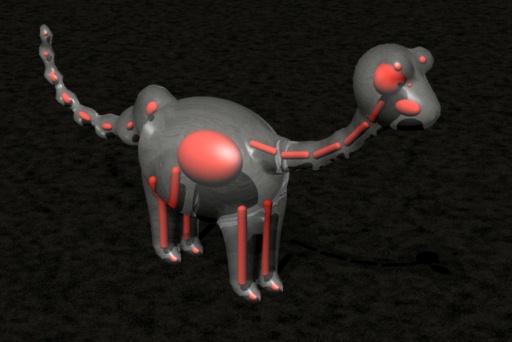Diffusion-limited aggregation and cellular automata provide
models of exogenous mechanisms of branching pattern formation.
In this case, components of the growing structure communicate through the
surrounding space. In contrast, L-systems simulate endogenous control
mechanisms, which rely on information flow within the developing structure.
Both lineage and interaction between adjacent modules are forms of endogenous
control.
In nature, endogenous and exogenous control mechanisms
are often combined. For example, the development of a tree is affected by
the genetically controlled formation of meristems (apices), the flow of
water, nutrients, and phytohormones through the branching structure, and
the plant response to environmental factors, such as the shading and crowding
of branches. Environmentally-sensitive L-systems represent one
of the approaches proposed to create comprehensive models integrating endogenous
and exogenous phenomena [Pru1994c].
In this case, development is assumed to take place in a space characterized
by a scalar or vector field. Modules of a growing plant test values of this
field at points of interest.
For example,
Animation 22
presents the
operation of an environmentally-sensitive L-system simulating the response
of a simple two-dimensional branching structure to pruning. The developing
structure is confined to a square, and the apices test whether they are
within or outside this area. During the initial phase of development the
apex of the main axis creates a sequence of internodes and dormant buds.
After crossing the bounding square the apex is pruned and a signal activating
the nearest dormant bud is sent basipetally. The activated bud initiates
a lateral branch, which grows in the same manner as the initial structure
(traumatic reiteration). After crossing the bounding square, the
apex of the reiterated branch is also pruned, and the bud-activating signal
is generated again. The final structure results from the repetition of this
process.
Three-dimensional extensions of the above model are shown
in
Animation 23
(without leaves), and in
Animation 24
(with leaves).
In both cases, some of the newly created buds initiate
new branches spontaneously, yielding tree-like structures. Pruning constrains
the outline of the growing plants to a cubical bounding box, and increases
the density of branches and leaves near the box boundaries.
 The pruning of plants to elaborate ornamental
shapes is termed topiary. For example,
Plate 26
shows a plant confined
to a bounding volume defined as the union of parallelepiped and a cylinder.
The pruning of plants to elaborate ornamental
shapes is termed topiary. For example,
Plate 26
shows a plant confined
to a bounding volume defined as the union of parallelepiped and a cylinder.

Plate 27
presents
a more complex bounding volume resembling a dinosaur. It has been constructed
as an implicit surface defined by the skeleton of lines and ellipsoids.
 Plate 28
shows the result of pruning a pair of trees to this dinosaur shape.
Plate 28
shows the result of pruning a pair of trees to this dinosaur shape.
|